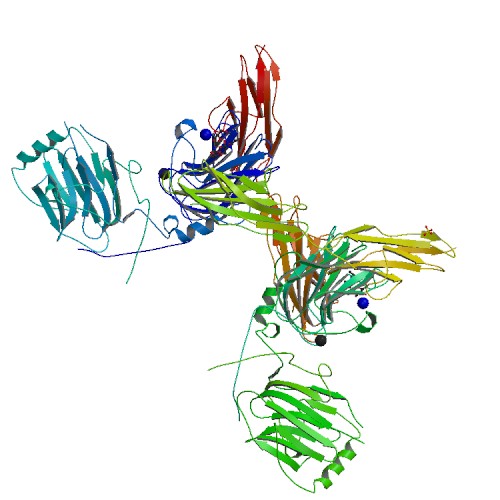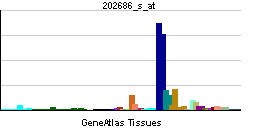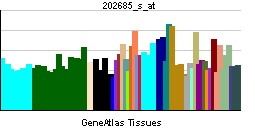AXL receptor tyrosine kinase
| AXL receptor tyrosine kinase | |||||||||||||
|---|---|---|---|---|---|---|---|---|---|---|---|---|---|
 PDB rendering based on 2c5d. | |||||||||||||
| |||||||||||||
| Identifiers | |||||||||||||
| Symbols | AXL ; UFO | ||||||||||||
| External IDs | Template:OMIM5 Template:MGI HomoloGene: 7583 | ||||||||||||
| |||||||||||||
| RNA expression pattern | |||||||||||||
 | |||||||||||||
 | |||||||||||||
| More reference expression data | |||||||||||||
| Orthologs | |||||||||||||
| Template:GNF Ortholog box | |||||||||||||
| Species | Human | Mouse | |||||||||||
| Entrez | n/a | n/a | |||||||||||
| Ensembl | n/a | n/a | |||||||||||
| UniProt | n/a | n/a | |||||||||||
| RefSeq (mRNA) | n/a | n/a | |||||||||||
| RefSeq (protein) | n/a | n/a | |||||||||||
| Location (UCSC) | n/a | n/a | |||||||||||
| PubMed search | n/a | n/a | |||||||||||
AXL receptor tyrosine kinase, also known as AXL, is a human gene.[1]
The protein encoded by this gene is a member of the receptor tyrosine kinase subfamily. Although it is similar to other receptor tyrosine kinases, the Axl protein represents a unique structure of the extracellular region that juxtaposes IgL and FNIII repeats. It transduce signals from the extracellular matrix into the cytoplasm by binding growth factors like vitamin K-dependent protein growth-arrest-specific gene 6. It is involved in the stimulation of cell proliferation. This receptor can also mediate cell aggregation by homophilic binding. Axl is a chronic myelogenous leukemia-associated oncogene and also associated with colon cancer and melanoma. It is in close vicinity to the bcl3 oncogene which is at 19q13.1-q13.2. The Axl gene is evolutionarily conserved between vertebrate species. This gene has two different alternatively spliced transcript variants.[1]
References
Further reading
- Neubauer A, Burchert A, Maiwald C; et al. (1997). "Recent progress on the role of Axl, a receptor tyrosine kinase, in malignant transformation of myeloid leukemias". Leuk. Lymphoma. 25 (1–2): 91–6. PMID 9130617.
- O'Bryan JP, Frye RA, Cogswell PC; et al. (1991). "axl, a transforming gene isolated from primary human myeloid leukemia cells, encodes a novel receptor tyrosine kinase". Mol. Cell. Biol. 11 (10): 5016–31. PMID 1656220.
- Bergsagel PL, Victor-Kobrin C, Timblin CR; et al. (1992). "A murine cDNA encodes a pan-epithelial glycoprotein that is also expressed on plasma cells". J. Immunol. 148 (2): 590–6. PMID 1729376.
- Janssen JW, Schulz AS, Steenvoorden AC; et al. (1991). "A novel putative tyrosine kinase receptor with oncogenic potential". Oncogene. 6 (11): 2113–20. PMID 1834974.
- Partanen J, Mäkelä TP, Alitalo R; et al. (1991). "Putative tyrosine kinases expressed in K-562 human leukemia cells". Proc. Natl. Acad. Sci. U.S.A. 87 (22): 8913–7. PMID 2247464.
- Neubauer A, Fiebeler A, Graham DK; et al. (1994). "Expression of axl, a transforming receptor tyrosine kinase, in normal and malignant hematopoiesis". Blood. 84 (6): 1931–41. PMID 7521695.
- O'Bryan JP, Fridell YW, Koski R; et al. (1995). "The transforming receptor tyrosine kinase, Axl, is post-translationally regulated by proteolytic cleavage". J. Biol. Chem. 270 (2): 551–7. PMID 7822279.
- Lee ST, Strunk KM, Spritz RA (1993). "A survey of protein tyrosine kinase mRNAs expressed in normal human melanocytes". Oncogene. 8 (12): 3403–10. PMID 8247543.
- Schulz AS, Schleithoff L, Faust M; et al. (1993). "The genomic structure of the human UFO receptor". Oncogene. 8 (2): 509–13. PMID 8381225.
- O'Bryan JP, Songyang Z, Cantley L; et al. (1996). "A mammalian adaptor protein with conserved Src homology 2 and phosphotyrosine-binding domains is related to Shc and is specifically expressed in the brain". Proc. Natl. Acad. Sci. U.S.A. 93 (7): 2729–34. PMID 8610109.
- Mark MR, Chen J, Hammonds RG; et al. (1996). "Characterization of Gas6, a member of the superfamily of G domain-containing proteins, as a ligand for Rse and Axl". J. Biol. Chem. 271 (16): 9785–9. PMID 8621659.
- Braunger J, Schleithoff L, Schulz AS; et al. (1997). "Intracellular signaling of the Ufo/Axl receptor tyrosine kinase is mediated mainly by a multi-substrate docking-site". Oncogene. 14 (22): 2619–31. doi:10.1038/sj.onc.1201123. PMID 9178760.
- Tanaka K, Nagayama Y, Nakano T; et al. (1998). "Expression profile of receptor-type protein tyrosine kinase genes in the human thyroid". Endocrinology. 139 (3): 852–8. PMID 9492013.
- Yanagita M, Arai H, Ishii K; et al. (2001). "Gas6 regulates mesangial cell proliferation through Axl in experimental glomerulonephritis". Am. J. Pathol. 158 (4): 1423–32. PMID 11290560.
- Sun WS, Misao R, Iwagaki S; et al. (2003). "Coexpression of growth arrest-specific gene 6 and receptor tyrosine kinases, Axl and Sky, in human uterine endometrium and ovarian endometriosis". Mol. Hum. Reprod. 8 (6): 552–8. PMID 12029073.
- D'Arcangelo D, Gaetano C, Capogrossi MC (2002). "Acidification prevents endothelial cell apoptosis by Axl activation". Circ. Res. 91 (7): e4–12. PMID 12364394.
- Hafizi S, Alindri F, Karlsson R, Dahlbäck B (2003). "Interaction of Axl receptor tyrosine kinase with C1-TEN, a novel C1 domain-containing protein with homology to tensin". Biochem. Biophys. Res. Commun. 299 (5): 793–800. PMID 12470648.
- Strausberg RL, Feingold EA, Grouse LH; et al. (2003). "Generation and initial analysis of more than 15,000 full-length human and mouse cDNA sequences". Proc. Natl. Acad. Sci. U.S.A. 99 (26): 16899–903. doi:10.1073/pnas.242603899. PMID 12477932.
- Ito M, Nakashima M, Nakayama T; et al. (2003). "Expression of receptor-type tyrosine kinase, Axl, and its ligand, Gas6, in pediatric thyroid carcinomas around chernobyl". Thyroid. 12 (11): 971–5. doi:10.1089/105072502320908303. PMID 12490074.
| This protein-related article is a stub. You can help Wikipedia by expanding it. |